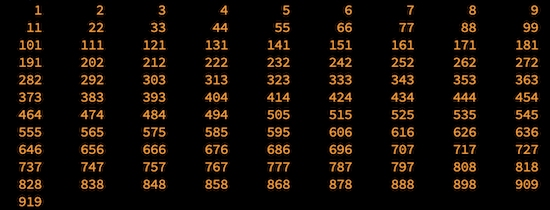The challenge for this month’s Exercise is to output the first 100 palindromic numbers, which are integers that reflect the same digits on either side. Rather than devise a complex mathematical equation to determine these values, I cheated.
Yes, just like the prior month’s Exercise (Cyclops numbers), I convert the integer value to a string, then use my handy strrev() function to compare the original with the reversed string. When they match, a palindromic value is found.
Here is the main() function from my solution (the listing omits the strrev() function).
2022_10-Exercise.c
int main()
{
const int total = 100;
const int size = 5; /* assume 5 digits max */
const int columns = 9;
int count,v,x,y;
int results[total];
char fwd[size+1]; /* +1 for the null char */
char *bkd;
/* find the palindromic values */
count = 0;
v = 1;
while(count<total)
{
/* eliminate single digits */
if( v < 10 )
{
results[count] = v;
count++;
}
else
{
snprintf(fwd,size,"%d",v);
bkd = strrev(fwd);
if(strcmp(bkd,fwd) == 0 )
{
results[count] = v;
count++;
}
}
v++;
}
/* output the results in a fancy table */
x = 0;
while( count )
{
for( y=0; y<columns; y++ )
{
printf("%5d",results[(x*columns)+y]);
count--; /* decrement the count */
if( !count ) /* if count is zero, stop */
break;
if( y<columns-1)
putchar('\t');
}
x++;
putchar('\n');
}
return(0);
}
A while loop counts the palindromic numbers, zero through 100. An if test handles single digit values (v < 10) as these are all considered palindromic.
The else portion of the decision uses the snprintf() function to convert integer v into a string fwd[]. The strrev() function reverses this string into a new string, char pointer bkd. The strcmp function compares the two values in an if decision. When they match, the number is palindromic. Its value is saved in array results[] and variable count is incremented.
The main() function’s second while loop outputs the results in a fancy table. The output is shown in Figure 1.

Figure 1. Output from my solution, using a table borrowed from last month’s solution.
I’d be curious to see a mathematical solution for this exercise. I assume you could use the modulo operator or perhaps some logarithmic witchcraft to peel off digits from the original integer. But even if you could re-splice these values into a new, reversed integer, how do you test to determine whether the two values are palindromic? Do the eggheads have a solution?
Regardless, I hope your solution, however it’s accomplished, met with success.
Forgot the “0”? Or isn’t that an integer?
Weird. I suppose I could have started at zero. Don’t know why I didn’t.
Yes, 0 is an integer. All whole numbers from – infinity through 0 to + infinity are integers.
I doubt whether there’s a mathematical way of calculating whether a number is palindromic but there are obvious patterns in the columns of individual digits (if output in a single column) which I think could be used somehow.
Alternatively you could try creating 2-digit strings in a loop where the second is the same as the first, so 11, 22, 33 etc, and then padding them in the middle with further palindromic numbers created with recursive function calls.
(I’ve no idea whether any of that stuff would work. Just odd ideas that floated into my brain and will hopefully float out again very soon.)